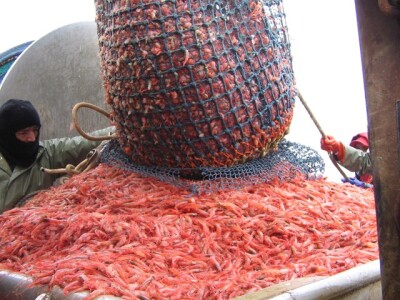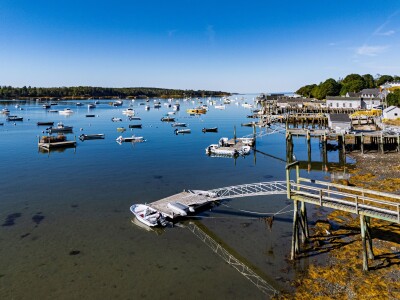Practicing to survive in cold water
A 37 1/2-foot steel vessel out of Sitka, Alaska, rigged for a combination of trolling and longlining, departed port on Wednesday, April 20, 2005, and anchored in Redfish Bay. The next morning, the vessel moved to fishing grounds approximately 23 nautical miles west of Cape Ommaney and began fishing.
About 10 miles en route to the fishing grounds, the two crewmen onboard experienced a steering problem. The vessel would respond to a command to port and center but not to starboard. The first mate, also the engineer, worked on the problem as the captain minded the helm. Suddenly, full steering control returned. The first mate did not believe anything he had done corrected the problem, but mysteriously, control returned. The steering remained normal for the next hour.
The men had just finished hauling a set. Normally they ran the vessel with both trolling poles out and the stabilizers in the water. However, in this case, they had one pole up to allow for hauling, which gave the boat a list to port. On a northwest course into the wind, the vessel was broadside to the waves.
As water started coming over the gunwale, the captain asked the first mate to turn more into the wind. The helm would not respond. Uncleaned fish on deck shifted to port, creating a greater list as the vessel began taking on water. The waves were 6 to 8 feet high, sharp and coming at irregular intervals. Every fifth or sixth wave crested. Sustained winds were at 18 knots, with gusts up to 30 knots. Water temperature was in the 40s. The current was 1 to 2 knots. It was nearly 6:30 p.m. There was still daylight, but evening was approaching. The first mate reported that this was the worst weather they'd experienced on this voyage.
Realizing the seriousness of their situation, the first mate donned his survival suit quickly, but the captain delayed to avoid any difficulty as he crawled under a tarp to get to the top of the bait shed where the life raft was. As the port list increased, the captain decided that getting the suit on was a higher priority. He never launched the raft.
The first mate cut the line going to the float bags off the starboard side, then went to the VHF radio in the troll pit to send out a distress signal. After hailing a mayday, he watched as the water started pouring into the hold, and he decided to leave the vessel. He could not see the captain.
The boat sank, and the first mate reunited with the captain in the water. The captain had donned his survival suit and appeared to be fine. The men grabbed a flagpole for flotation and tried to get to the raft when it surfaced 50 to 75 yards away, but the wind took the raft away faster than they could swim. To make themselves more visible, the men gathered floating debris around themselves. By this time, it was beginning to get dark. They had been in the water almost 45 minutes when the captain became hypothermic and lost his grip on the flagpole.
A Coast Guard helicopter from Air Station Sitka launched at 7:28 p.m. in response to the EPIRB's signal. A good Samaritan vessel responding to an urgent marine information broadcast assisted in the search. Before 7:55 p.m., the helicopter crew located the empty life raft. At 8:15, they spotted two men in the water. The first mate was clinging to a small orange buoy, and the captain was horizontal.
The good Samaritan vessel arrived on scene shortly thereafter and brought the first mate onboard. A rescue swimmer recovered the captain, who was unresponsive. The swimmer noted that the captain's suit was zipped up all the way but was full of water, indicating that he may not have finished donning the suit until after he entered the water. The aircrew performed CPR on the captain during the flight to Sitka, where he was transferred to Mount Edgecumbe Hospital. The captain was declared dead as a result of hypothermia. The first mate survived without injury.
Lessons learned
Most people are aware that being exposed to cold water without protection can lead to hypothermia because the loss of heat from your body can occur rapidly. You must be prepared to protect yourself from exposure and your body from the shock of entering cold water. Immersion suits provide this protection but only if donned correctly and fully.
The accepted critical water temperature is 59 degrees F. To the unprotected person, water at this temperature or colder is painful upon entry. Protective equipment enhances but does not guarantee survival in cold water.
Immersion suits are required on commercial fishing vessels operating in cold water. Specifically, that is beyond the boundary line north of 32 degrees north and on Lake Superior for documented vessels. All vessels operating in coastal waters on the West Coast of the United States north of Point Reyes, Calif., beyond coastal waters in cold water, and on Lake Superior must carry immersion suits.
The Coast Guard's Navigation and Vessel Inspection Circular No. 7-91, entitled "Determination of Cold Water Areas," provides descriptions and maps of "seasonally" U.S. cold-water areas.
If you have to abandon ship, ideally you will enter a survival craft dry. But being in a survival craft, even wet, will keep you warmer than staying in the water. Unfortunately, as in this case, conditions sometimes make it difficult to get to the survival craft.
There are techniques to increase survival time when stranded in water, with or without an immersion suit. Remain calm and don't swim aimlessly. Stay with other survivors and huddle together. If alone, use the Heat Escape Lessening Position (HELP) to slow down heat loss.
Survivors confirm that training and drills will help save your life and the lives of others. Practice to survive!
This article is based on U.S. Coast Guard reporting and is intended to bring safety issues to the attention of our readers. It is not intended to judge or reach conclusions regarding the ability or capacity of any person, living or dead, or any boat or piece of equipment.






